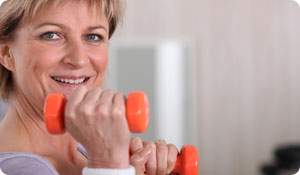
One might not typically think that exercise would be the best treatment for pain; however there is evidence that exercise may be one of the best things you can do to manage chronic pain.
4 Reasons Why Exercise Helps
- When you exercise, you produce endorphins which are natural chemicals in your body that have the same kind of effect as painkilling opiates like morphine or codeine. Furthermore, endorphins create a general feeling of well-being.
- Tension and stress can increase your pain. When you exercise, you release tension, therefore reducing your pain.
- Most chronic pain sufferers have difficulty sleeping, and an inadequate sleep cycle can lead a chronic pain patient into a downward spiral. Getting regular exercise improves your ability to fall asleep and your quality of sleep. This in turn can reduce your pain and help you cope better with any pain you experience.
- If chronic pain happens after an injury, targeted exercises can help strengthen the muscles around the injury, which can take pressure off of the injured tissue.
Important Note: If any of the following exercises increase your pain level, discontinue the exercise and talk to your health care provider about some alternatives.
Home Exercises for Pain Management
Arm circles. Extend your arms out at both sides. Rotate your arms forward for 20 seconds, then in reverse for 20 seconds. Relax arms down and breathe deeply for 10 seconds.
Side bends. Reach your arms and hands above your head. Interlace your fingers. Stretch from the waist to one side. Breathe for 10 seconds. Then come back up. Repeat on the other side.
Torso rotations. Stand with feet shoulder-width apart and toes turned slightly out. Rotate to your left side. Then rotate to your right side. Let your arms flap from side to side. Keep shoulders loose. Find a rhythm and rotate for up to one minute.
Lower back stretch. Lie on the floor with your legs out straight. Slowly draw your knees into your chest and breathe. Then slowly rock from side to side giving your lower back a massage. Breathe deeply and continue the exercise for at least one minute.
Abdominal strengthening. From the same position on your back, place your feet flat on the floor. Interlace your hands behind your head. Using your abdominal muscles, lift your chest toward your thighs. Then return your back to the floor. Do exercise for at least 30 seconds. If possible, repeat a second set.
Wall push-up. This exercise is great to strengthen your upper body and core. Stand with your feet about 12 inches from a wall. Place your hands a little wider than your shoulders. Lower your chest to the wall, then push back to the starting position. Do 3 sets of 10, if possible. Pay attention to when you need to rest.
Walk around the neighborhood. Walking is so good for you. Brisk walking will definitely get your endorphins going. Put on sneakers or a comfortable pair of shoes and walk around your neighborhood for at least 20 minutes. Do this three to five times a week for best pain management results.
Note: Talk to your doctor about additional at-home exercises that can help you manage your pain.
Sources:
Davis, Jeanie Lerche. "Exercises Can Ease Arthritis Pain." WebMD. 11 Apr. 2010. http://www.webmd.com/pain-management/guide/exercise-can-ease-arthritis-pain
"Exercises for Pain Management." GrayClinic.com. Web 11 Apr. 2010. http://painmanagement.grayclinic.com/painmanagementexercise.html
Gardner, Tanja. "Natural Pain Management: Exercise and Chronic Pain." Web. 11 Apr. 2010. http://www.bodybuildingforyou.com/articles-submit/tanja-gardner/natural-pain-management.htm
Mayo Clinic Staff. "Back Pain." MayoClinic.com. Web. 11 Apr. 2010. http://www.mayoclinic.com/health/back-pain/DS00171





